Randomly Generating the 3D Mesostructure of Soil Rock Mixtures Based on the Full In Situ Digital Image Processed Information
Abstract
1. Introduction
2. Full In Situ SRM Mesostructure Characterization
3. 3D Mesostructure-Generating Algorithm
3.1. Mesostructure Generation Procedure
3.2. Generation of the Single Grain
3.2.1. Generation of Angular Grains
- Based on the given grain size, generate a pre-defined sphere with a diameter equal to the grain size. This sphere is not part of the created grain and is used to ensure that all generated vertices are within the defined range.
- Generate the base tetrahedron. An example of the base tetrahedron is shown in Figure 3a. For the base tetrahedron, two vertices, A and B, are fixed as two vertices on the diameter of the pre-defined sphere, and the other two vertices, C and D, are randomly picked within the sphere. In this way, the size of the generated grain is the distance between points A and B (i.e., the given grain size).
- Generate a new vertex on the triangle with the largest surface area. An example of this step is shown in Figure 3b. Taking the triangle ADC as an example, the surface area was calculated by the equation as follows:Once the triangle with the largest surface area was determined, the new vertex E was generated by a vector that passed through the center of the pre-defined sphere (O), along with the normal vector of the triangle. The length of OE was determined by multiplying the radius of the sphere by a random number ranging from 0 to 1.
- Generate a new tetrahedron based on the newly generated vertex E. The new tetrahedron was formed by the three vertices of the triangle with the largest surface area (ADC in Figure 3b) and the newly generated vertex E.
- Repeat steps 3 to 4 until the number of vertices or the maximum surface area reaches the requirement.
3.2.2. Generation of Rounded Grains
- Like the generation process of angular grains, the first step of generating rounded grains is generating a pre-defined sphere based on the given grain size. The diameter of the sphere is equal to the grain size. Two vertices on the diameter of the pre-defined sphere, A and B, are selected at the initial vertices of the grain.
- Randomly pick several points on the diameter AB and determine the intersections that are perpendicular to AB, as shown in Figure 4a.
- For each intersection, randomly select several points within the intersected circle; then, add a random offset d on the AB direction, as shown in Figure 4b.
- Connect all generated vertices and form the grains, as shown in Figure 4c.
3.3. Grain Rotation and Placement
3.4. Collision Detection
3.5. Fractal Dimension Calculation of the Generated SRM Cross-Section
4. Influence of Rock Content and Shape on the Fractal Dimension
5. Examples of Numerical Modeling Based on the Proposed Algorithm
6. Conclusions
- In contrast to earlier generation methods, the suggested method considers the fractal dimension and particle shape during generation. With the in situ SRMs, the suggested method reconstructs statistically similar mesostructures more reliably.
- With an increase in rock content, the cross-sections of the produced mesostructure become more fractal in nature. This is because the number of particles increased with the increase in the rock content or angular particle proportion.
- Only when the proportion of angular particles is less than 75% does the content have an impact on the fractal dimension. With an increase in the proportion of angular particles, the fractal dimension increases.
Author Contributions
Funding
Institutional Review Board Statement
Informed Consent Statement
Data Availability Statement
Conflicts of Interest
References
- Xu, W.-J.; Yue, Z.-Q.; Hu, R.-L. Study on the mesostructure and mesomechanical characteristics of the soil-rock mixture using digital image processing based finite element method. Int. J. Rock Mech. Min. Sci. 2008, 45, 749–762. [Google Scholar] [CrossRef]
- Luan, B.; Zhou, W.; Meng, X.; Lu, X.; Liu, Z. Study on Permeability of Soil-Rock Mixture in Water-Blocking Layer of Open-Pit Coal Mine Dump Site. Adv. Civ. Eng. 2020, 2020, 1925849. [Google Scholar] [CrossRef]
- Yang, G.-Q.; Liu, H.; Zhou, Y.-T.; Xiong, B.-L. Post-construction performance of a two-tiered geogrid reinforced soil wall backfilled with soil-rock mixture. Geotext. Geomembr. 2014, 42, 91–97. [Google Scholar] [CrossRef]
- Gao, W.-W.; Gao, W.; Hu, R.-L.; Xu, P.-F.; Xia, J.-G. Microtremor survey and stability analysis of a soil-rock mixture landslide: A case study in Baidian town, China. Landslides 2018, 15, 1951–1961. [Google Scholar] [CrossRef]
- Zhou, Z.; Yang, H.; Wang, X.; Liu, B. Model Development and Experimental Verification for Permeability Coefficient of Soil–Rock Mixture. Int. J. Geomech. 2017, 17, 04016106. [Google Scholar] [CrossRef]
- Medley, E.W. Orderly characterization of chaotic Franciscan Melanges. Eng. Geol. 2001, 19, 20–32. [Google Scholar]
- Zhang, H.-Y.; Xu, W.-J.; Yu, Y.-Z. Triaxial tests of soil-rock mixtures with different rock block distributions. Soils Found. 2016, 56, 44–56. [Google Scholar] [CrossRef]
- Dong, H.; Peng, B.; Gao, Q.-F.; Hu, Y.; Jiang, X. Study of hidden factors affecting the mechanical behavior of soil–rock mixtures based on abstraction idea. Acta Geotech. 2021, 16, 595–611. [Google Scholar] [CrossRef]
- Coli, N.; Berry, P.; Boldini, D.; Bruno, R. The contribution of geostatistics to the characterisation of some bimrock properties. Eng. Geol. 2012, 137–138, 53–63. [Google Scholar] [CrossRef]
- Afifipour, M.; Moarefvand, P. Mechanical behavior of bimrocks having high rock block proportion. Int. J. Rock Mech. Min. Sci. 2014, 65, 40–48. [Google Scholar] [CrossRef]
- Kalender, A.; Sonmez, H.; Medley, E.; Tunusluoglu, C.; Kasapoglu, K. An approach to predicting the overall strengths of unwelded bimrocks and bimsoils. Eng. Geol. 2014, 183, 65–79. [Google Scholar] [CrossRef]
- Wang, Y.; Li, C.; Hu, Y. Use of X-ray computed tomography to investigate the effect of rock blocks on meso-structural changes in soil-rock mixture under triaxial deformation. Constr. Build. Mater. 2018, 164, 386–399. [Google Scholar] [CrossRef]
- Qian, J.; Yao, Y.; Li, J.; Xiao, H.; Luo, S. Resilient Properties of Soil-Rock Mixture Materials: Preliminary Investigation of the Effect of Composition and Structure. Materials 2020, 13, 1658. [Google Scholar] [CrossRef] [PubMed]
- Meng, Q.; Wang, H.; Xu, W.; Zhang, Q. A coupling method incorporating digital image processing and discrete element method for modeling of geomaterials. Eng. Comput. 2018, 35, 411–431. [Google Scholar] [CrossRef]
- Meng, Q.; Wang, H.; Xu, W.; Cai, M. A numerical homogenization study of the elastic property of a soil-rock mixture using random mesostructure generation. Comput. Geotech. 2018, 98, 48–57. [Google Scholar] [CrossRef]
- Chen, L.; Yang, Y.; Zheng, H. Numerical study of soil-rock mixture: Generation of random aggregate structure. Sci. China Technol. Sci. 2018, 61, 359–369. [Google Scholar] [CrossRef]
- Xu, W.-J.; Zhang, H.-Y.; Jie, Y.-X.; Yu, Y.-Z. Generation of 3D random meso-structure of soil-rock mixture and its meso-structural mechanics based on numerical tests. J. Cent. S. Univ. 2015, 22, 619–630. [Google Scholar] [CrossRef]
- Sheng, P.; Zhang, J.; Ji, Z. An advanced 3D modeling method for concrete-like particle-reinforced composites with high volume fraction of randomly distributed particles. Compos. Sci. Technol. 2016, 134, 26–35. [Google Scholar] [CrossRef]
- Meng, Q.; Wang, H.; Cai, M.; Xu, W.; Zhuang, X.; Rabczuk, T. Three-dimensional mesoscale computational modeling of soil-rock mixtures with concave particles. Eng. Geol. 2020, 277, 105802. [Google Scholar] [CrossRef]
- Yao, Y.; Li, J.; Ni, J.; Liang, C.; Zhang, A. Effects of gravel content and shape on shear behaviour of soil-rock mixture: Experiment and DEM modelling. Comput. Geotech. 2022, 141, 104476. [Google Scholar] [CrossRef]
- Bergen, G.V.D. A fast and robust GJK implementation for collision detection of convex objects. J. Graph. Tools 1999, 4, 7–25. [Google Scholar] [CrossRef]
- Kockara, S.; Halic, K.; Iqbal, K.; Bayrak, C.; Rowe, R. Collision Detection: A Survey. In Proceedings of the 2007 IEEE International Conference on Systems, Man and Cybernetics, Montreal, QC, Canada, 7–10 October 2007. [Google Scholar]

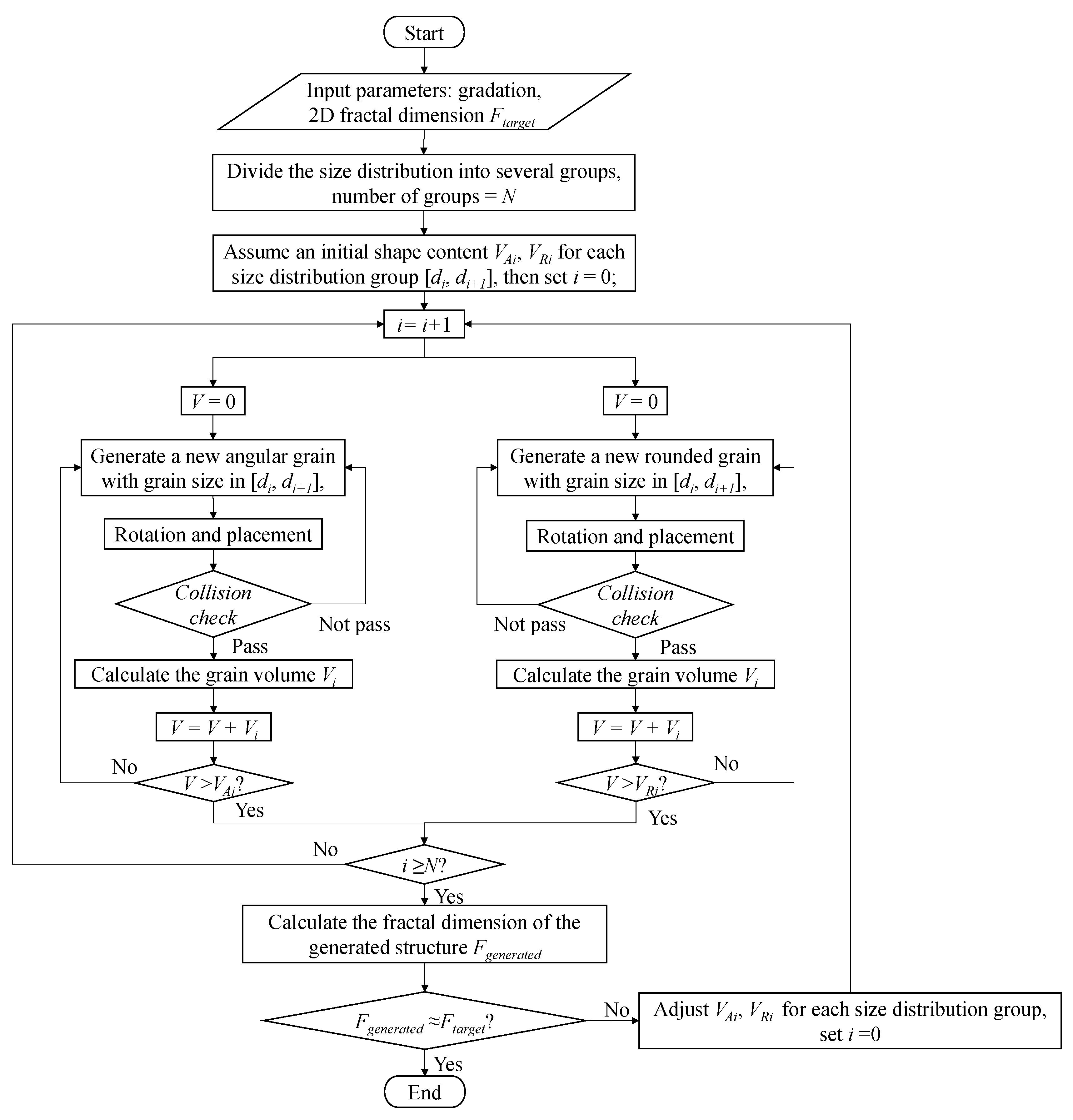

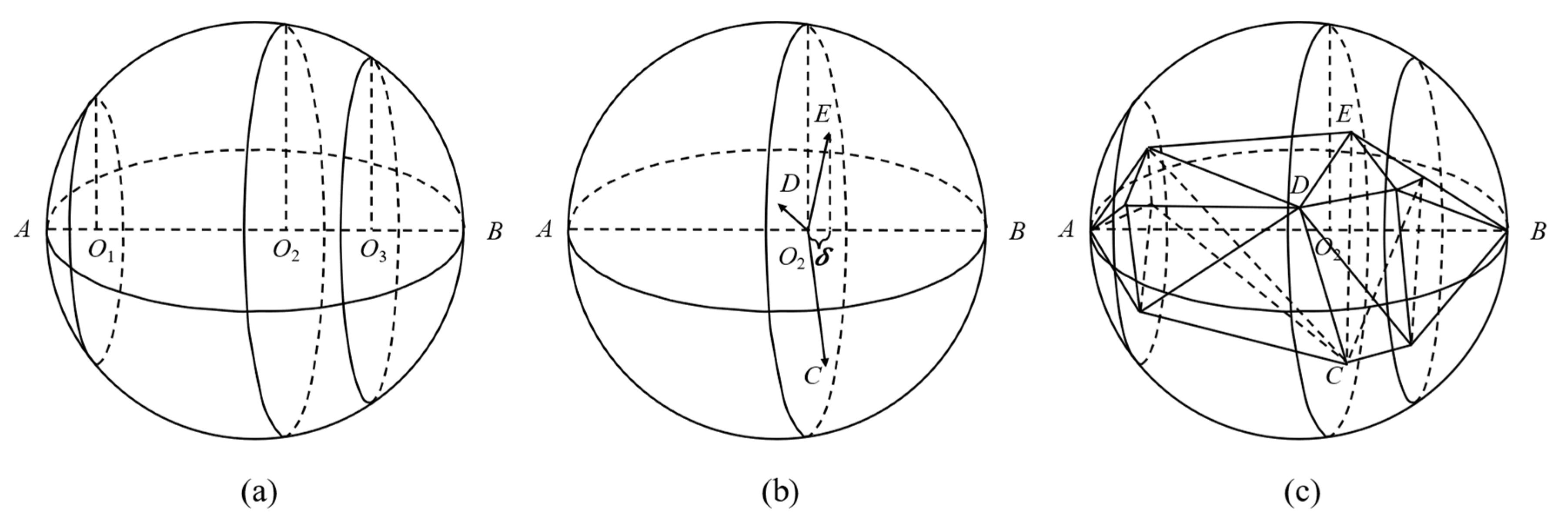

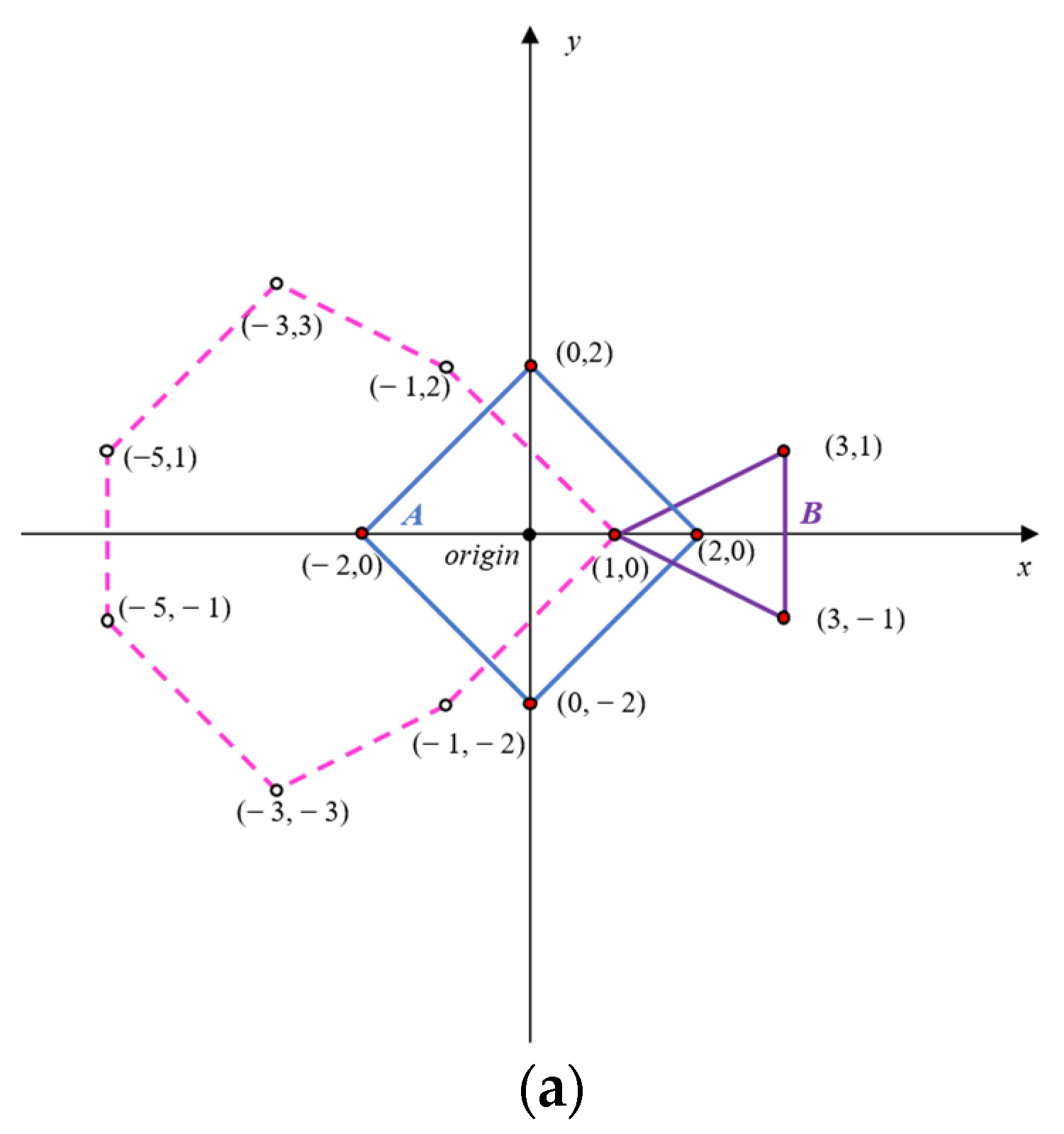

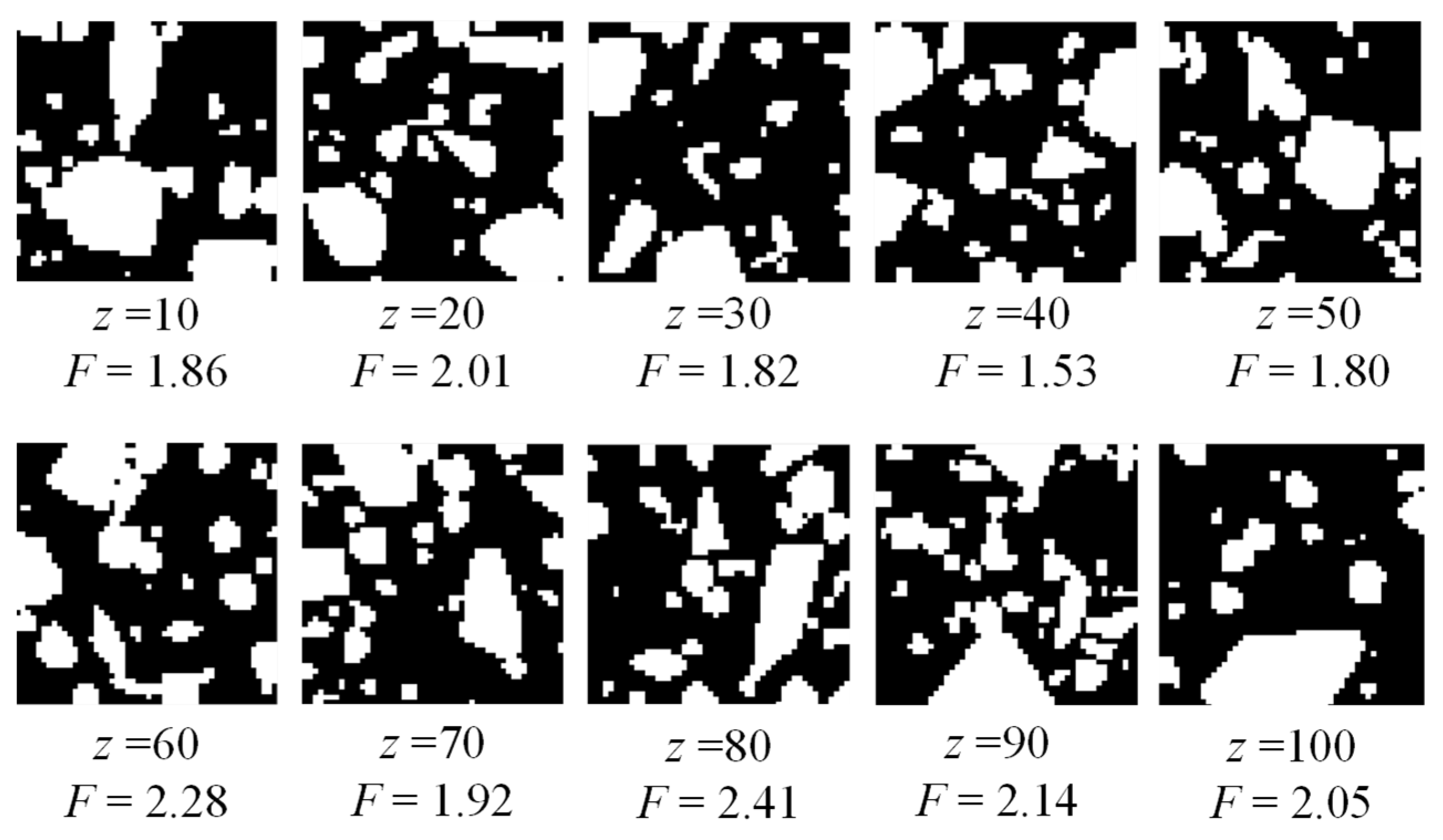
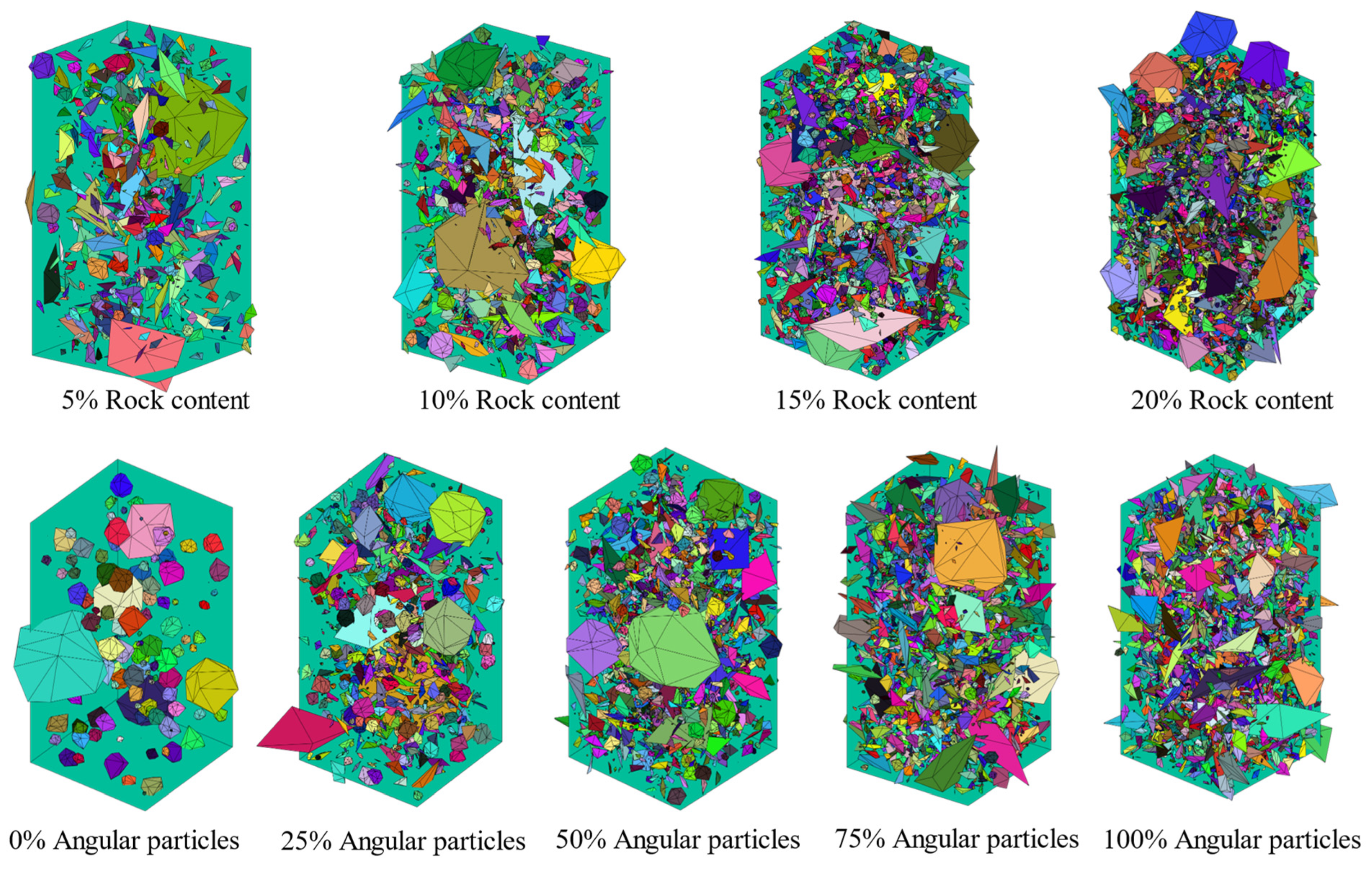
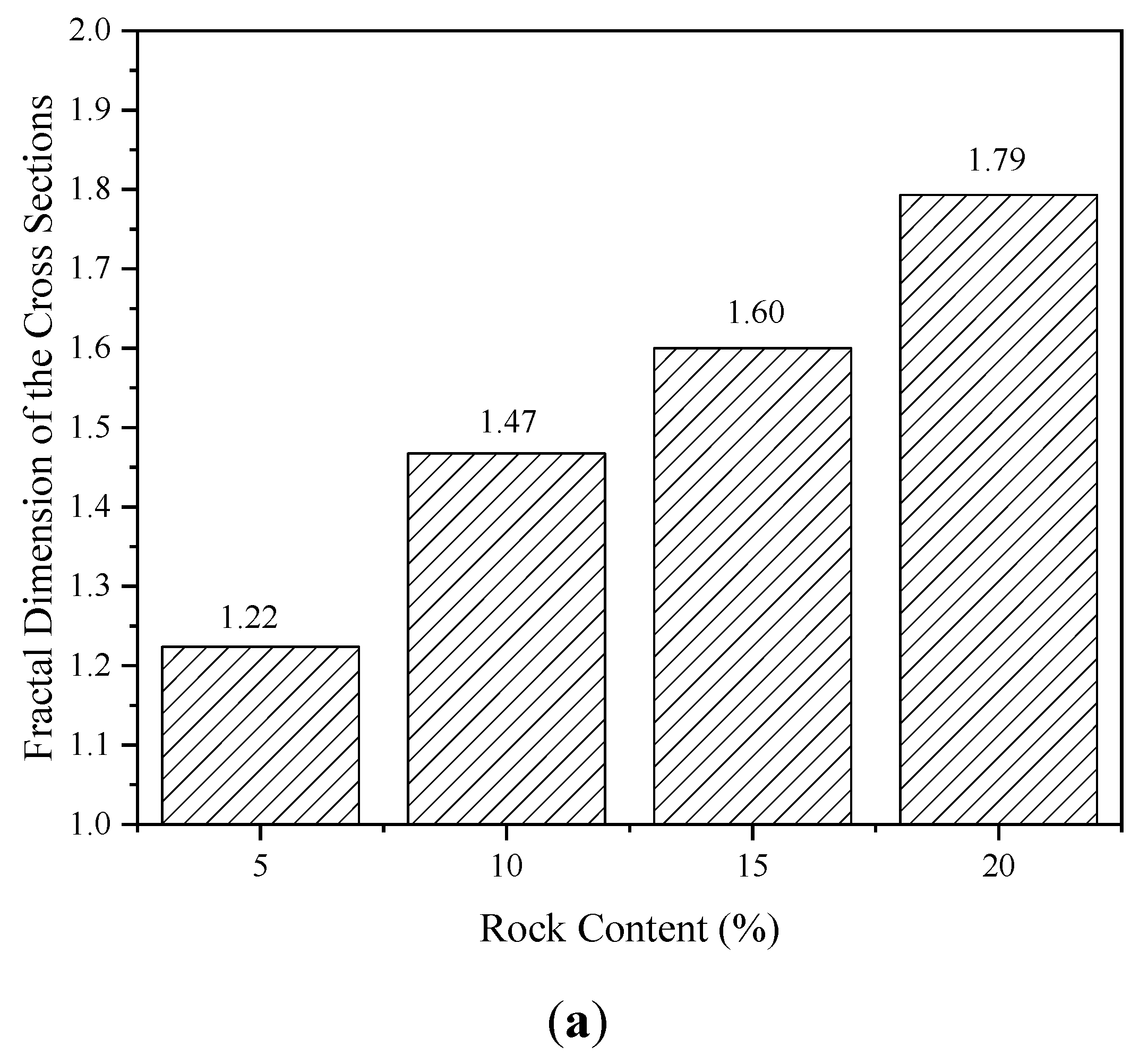


| Size Range (cm) | Angular Particles Content | Rounded Particles Content | Overall Rock Content (%) | |||||
|---|---|---|---|---|---|---|---|---|
| Group No. | 5–10 | 10–15 | 15–20 | 5–10 | 10–15 | 15–20 | ||
| 1 | 1 | 1 | 0.5 | 1 | 1 | 0.5 | 5 | |
| 2 | 2 | 2 | 1 | 2 | 2 | 1 | 10 | |
| 3 | 3 | 3 | 1.5 | 3 | 3 | 1.5 | 15 | |
| 4 | 4 | 4 | 2 | 4 | 4 | 2 | 20 | |
| 5 | 0 | 0 | 0 | 4 | 4 | 2 | 10 | |
| 6 | 1 | 1 | 0.5 | 3 | 3 | 1.5 | 10 | |
| 7 | 3 | 3 | 1.5 | 1 | 1 | 0.5 | 10 | |
| 8 | 4 | 4 | 2 | 0 | 0 | 0 | 10 | |
Publisher’s Note: MDPI stays neutral with regard to jurisdictional claims in published maps and institutional affiliations. |
© 2022 by the authors. Licensee MDPI, Basel, Switzerland. This article is an open access article distributed under the terms and conditions of the Creative Commons Attribution (CC BY) license (https://creativecommons.org/licenses/by/4.0/).
Share and Cite
Li, Z.; Yi, H.; Zhu, C.; Zhuo, Z.; Liu, G. Randomly Generating the 3D Mesostructure of Soil Rock Mixtures Based on the Full In Situ Digital Image Processed Information. Fractal Fract. 2022, 6, 570. https://doi.org/10.3390/fractalfract6100570
Li Z, Yi H, Zhu C, Zhuo Z, Liu G. Randomly Generating the 3D Mesostructure of Soil Rock Mixtures Based on the Full In Situ Digital Image Processed Information. Fractal and Fractional. 2022; 6(10):570. https://doi.org/10.3390/fractalfract6100570
Chicago/Turabian StyleLi, Zhengsheng, Haiyang Yi, Cheng Zhu, Zhuang Zhuo, and Guoshuan Liu. 2022. "Randomly Generating the 3D Mesostructure of Soil Rock Mixtures Based on the Full In Situ Digital Image Processed Information" Fractal and Fractional 6, no. 10: 570. https://doi.org/10.3390/fractalfract6100570
APA StyleLi, Z., Yi, H., Zhu, C., Zhuo, Z., & Liu, G. (2022). Randomly Generating the 3D Mesostructure of Soil Rock Mixtures Based on the Full In Situ Digital Image Processed Information. Fractal and Fractional, 6(10), 570. https://doi.org/10.3390/fractalfract6100570






